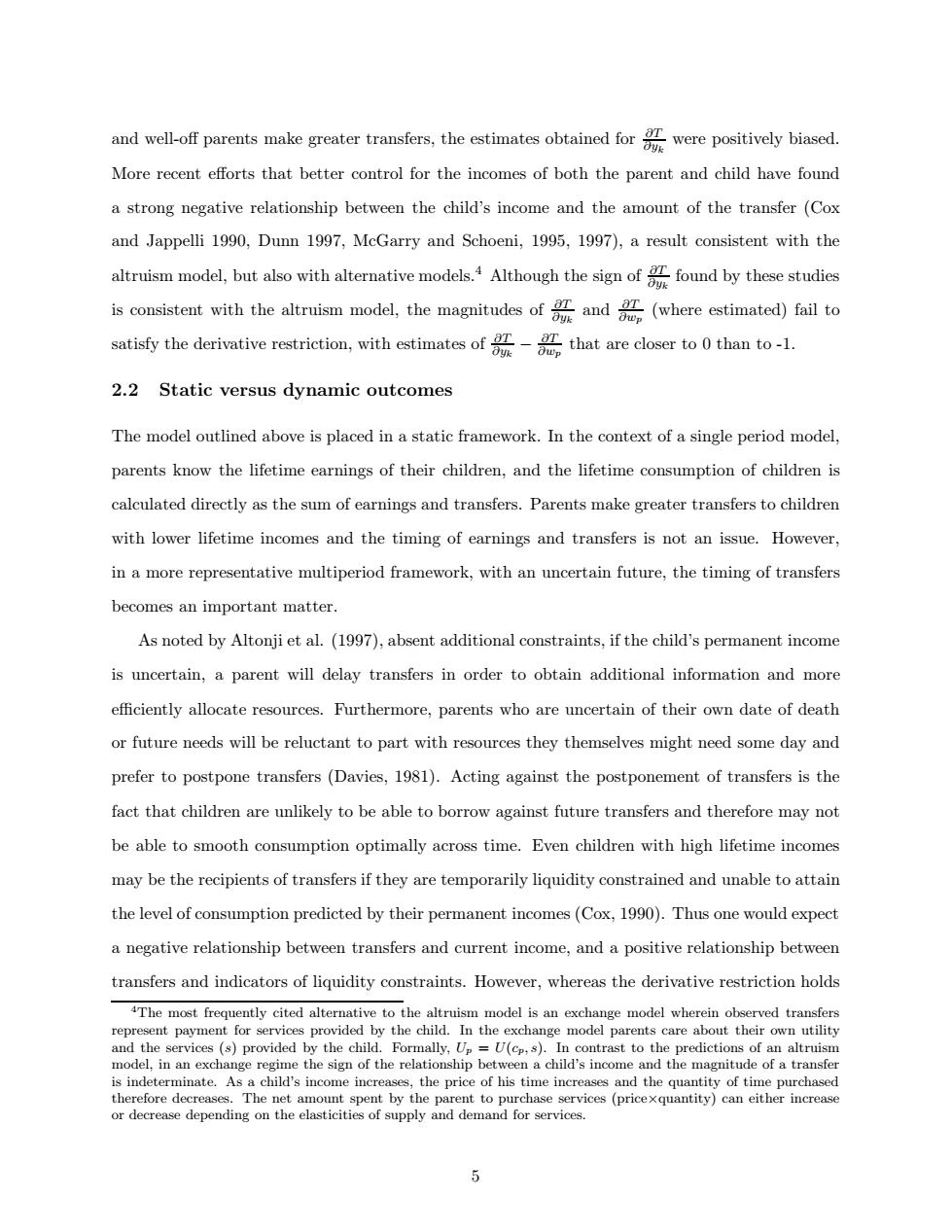正在加载图片...

and well-off parents make greater transfers,the estimates obtained forwere positively biased. More recent efforts that better control for the incomes of both the parent and child have found a strong negative relationship between the child's income and the amount of the transfer (Cox and Jappelli 1990,Dunn 1997,McGarry and Schoeni,1995,1997),a result consistent with the altruism model,but also with alternative models.Although the sign offound by these studies is conistent with the altruism model,the magnitudes ofand(where estimated)fail to satisfy the derivative restriction,with estimatesofthat are closer tothan to-1. 2.2 Static versus dynamic outcomes The model outlined above is placed in a static framework.In the context of a single period model, parents know the lifetime earnings of their children,and the lifetime consumption of children is calculated directly as the sum of earnings and transfers.Parents make greater transfers to children with lower lifetime incomes and the timing of earnings and transfers is not an issue.However, in a more representative multiperiod framework,with an uncertain future,the timing of transfers becomes an important matter. As noted by Altonji et al.(1997),absent additional constraints,if the child's permanent income is uncertain,a parent will delay transfers in order to obtain additional information and more efficiently allocate resources.Furthermore,parents who are uncertain of their own date of death or future needs will be reluctant to part with resources they themselves might need some day and prefer to postpone transfers (Davies,1981).Acting against the postponement of transfers is the fact that children are unlikely to be able to borrow against future transfers and therefore may not be able to smooth consumption optimally across time.Even children with high lifetime incomes may be the recipients of transfers if they are temporarily liquidity constrained and unable to attain the level of consumption predicted by their permanent incomes(Cox,1990).Thus one would expect a negative relationship between transfers and current income,and a positive relationship between transfers and indicators of liquidity constraints.However,whereas the derivative restriction holds 4The most frequently cited alternative to the altruism model is an exchange model wherein observed transfers represent payment for services provided by the child.In the exchange model parents care about their own utility and the services(s)provided by the child.Formally,Up=U(cp,s).In contrast to the predictions of an altruism model,in an exchange regime the sign of the relationship between a child's income and the magnitude of a transfer is indeterminate.As a child's income increases,the price of his time increases and the quantity of time purchased therefore decreases.The net amount spent by the parent to purchase services(pricexquantity)can either increase or decrease depending on the elasticities of supply and demand for services. 5and well-off parents make greater transfers, the estimates obtained for ∂T ∂yk were positively biased. More recent efforts that better control for the incomes of both the parent and child have found a strong negative relationship between the child’s income and the amount of the transfer (Cox and Jappelli 1990, Dunn 1997, McGarry and Schoeni, 1995, 1997), a result consistent with the altruism model, but also with alternative models.4 Although the sign of ∂T ∂yk found by these studies is consistent with the altruism model, the magnitudes of ∂T ∂yk and ∂T ∂wp (where estimated) fail to satisfy the derivative restriction, with estimates of ∂T ∂yk − ∂T ∂wp that are closer to 0 than to -1. 2.2 Static versus dynamic outcomes The model outlined above is placed in a static framework. In the context of a single period model, parents know the lifetime earnings of their children, and the lifetime consumption of children is calculated directly as the sum of earnings and transfers. Parents make greater transfers to children with lower lifetime incomes and the timing of earnings and transfers is not an issue. However, in a more representative multiperiod framework, with an uncertain future, the timing of transfers becomes an important matter. As noted by Altonji et al. (1997), absent additional constraints, if the child’s permanent income is uncertain, a parent will delay transfers in order to obtain additional information and more efficiently allocate resources. Furthermore, parents who are uncertain of their own date of death or future needs will be reluctant to part with resources they themselves might need some day and prefer to postpone transfers (Davies, 1981). Acting against the postponement of transfers is the fact that children are unlikely to be able to borrow against future transfers and therefore may not be able to smooth consumption optimally across time. Even children with high lifetime incomes may be the recipients of transfers if they are temporarily liquidity constrained and unable to attain the level of consumption predicted by their permanent incomes (Cox, 1990). Thus one would expect a negative relationship between transfers and current income, and a positive relationship between transfers and indicators of liquidity constraints. However, whereas the derivative restriction holds 4The most frequently cited alternative to the altruism model is an exchange model wherein observed transfers represent payment for services provided by the child. In the exchange model parents care about their own utility and the services (s) provided by the child. Formally, Up = U(cp, s). In contrast to the predictions of an altruism model, in an exchange regime the sign of the relationship between a child’s income and the magnitude of a transfer is indeterminate. As a child’s income increases, the price of his time increases and the quantity of time purchased therefore decreases. The net amount spent by the parent to purchase services (price×quantity) can either increase or decrease depending on the elasticities of supply and demand for services. 5